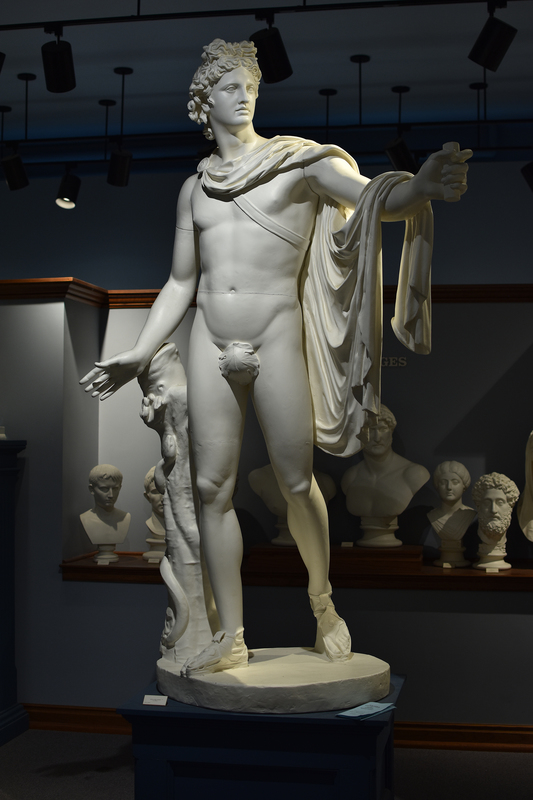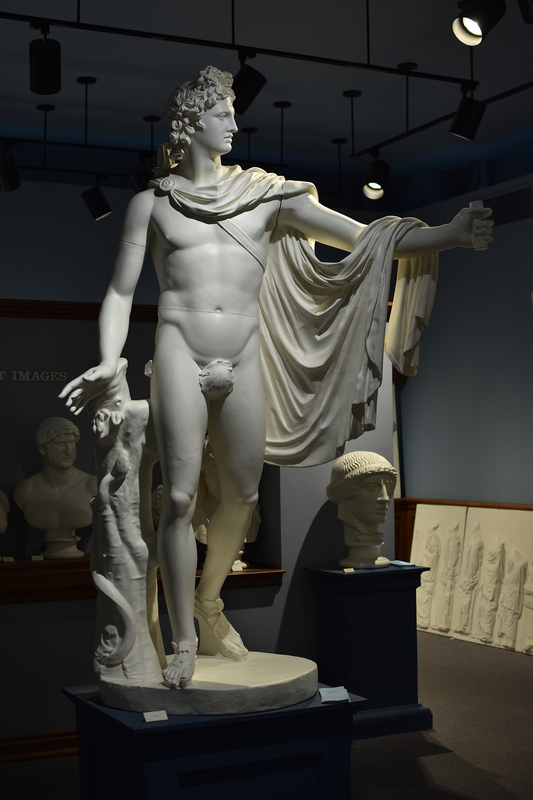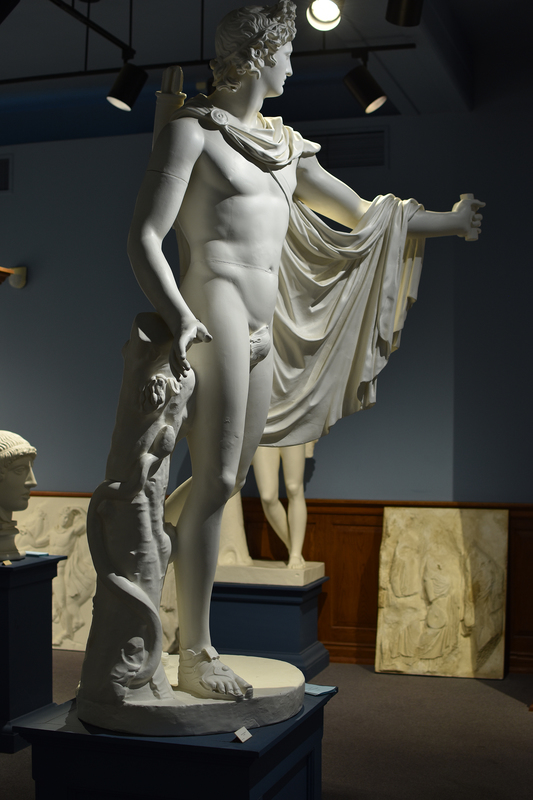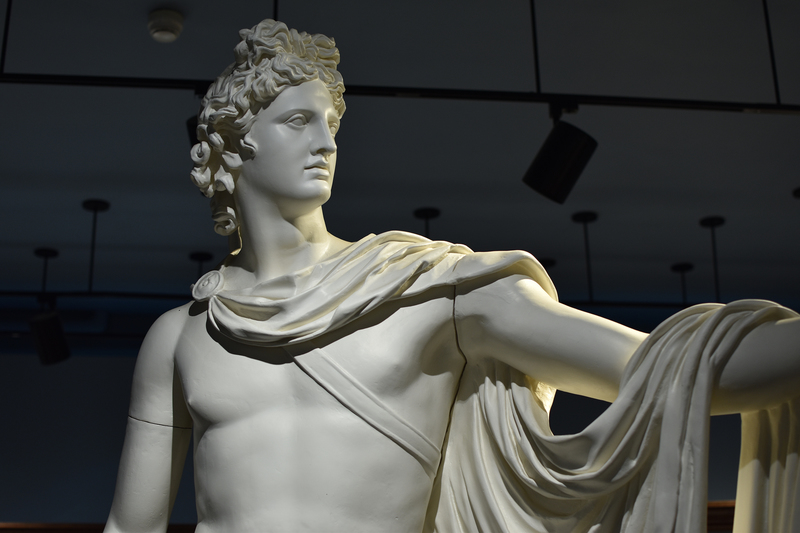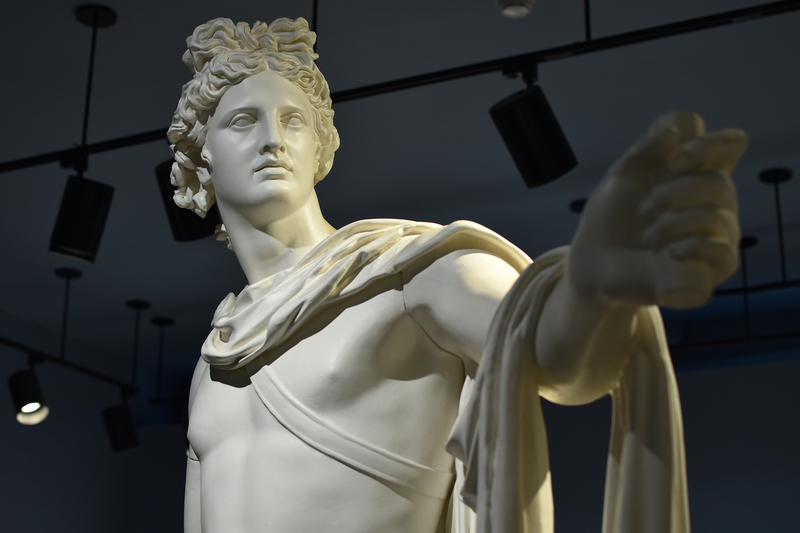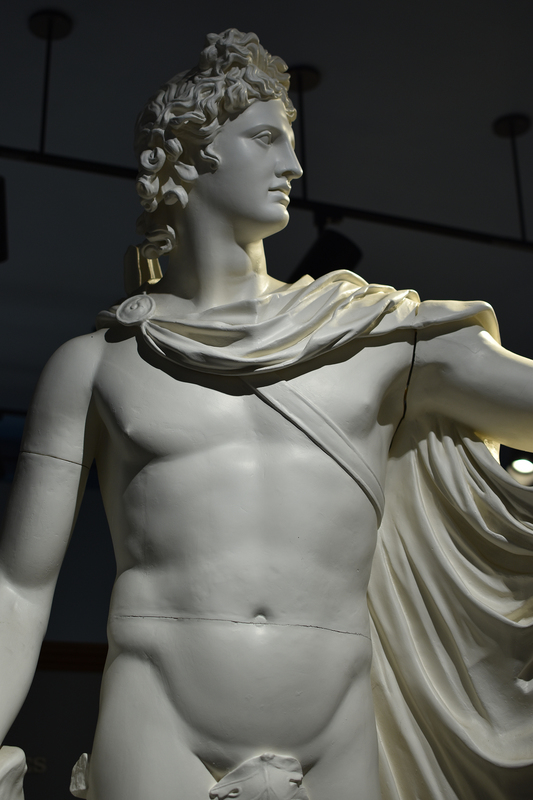-
Title
-
Apollo Belvedere
-
Description
-
Cast based on an original in the Vatican Museums, Rome (Vatican Museum, Museo Pio Clementino, Cortile Ottagono no. 1015. Marble. H. 2.24 m, 7 ft. 4 in.) This over-life sized statue of the god Apollo takes its epithet from the Belvedere Gallery of the Vatican Museum in Rome where he once stood. The figure has been known since the 16th c. C.E., but his precise findspot is uncertain (probably Rome itself). Long considered to be a marble copy of a Greek bronze original by Leochares (ca. 330 B.C.), most scholars now believe he is a Roman re-creation or adaptation in Greek style and date him to A.D. 130-140, around the time of the emperor Hadrian (ruled 117-138).
Apollo was one of the most popular of Classical gods, and he appears frequently in both Greek and Roman literature and art. He was the son of Zeus (Latin Jupiter) and a minor goddess, Leto (Latona); his twin sister was Artemis (Diana). His major sanctuaries, at Delphi in mainland Greece and on the island of Delos in the Aegean Sea, were famous, and were visited often by tourists - just as they are today. Worshippers could also consult an oracle in each location. As a youthful god and a favored son of Zeus, he was patron of young men and male beauty and the civilized order of the city and civic institutions like art and music. His stories celebrate his prowess as a hunter and lover. At the hands of the Latin author Ovid, he became a humorous subject as well (Metamorphoses I.457 ff.: Apollo and Daphne; she turned into a laurel or bay tree and her leaves thereafter became his personal symbol and a sign of victory).
The Belvedere statue depicts the handsome young god as a hunter. His pose is dynamic: he strides forward on his right leg with the left trailing slightly. (A tree trunk carved with a snake behind the right buttock helps support the figure, especially at ankle-level, the weakest point of any marble statue). The right arm, extended along his side, lacks the forearm and hand (holding a laurel branch originally?). The left arm (its hand also missing) was extended nearly horizontal away from the body, perhaps to grasp a bow, now also missing. Regardless of the attribute, the extension of the arm into space is a tour de force of the stone carver's craft, not least because it also supports the weight of a cloak around the neck and along the left arm; its curving folds are unsupported between shoulder and wrist. Viewed from the front, the turn of Apollo's head to his left side shows off his strikingly 'classical' profile to best advantage. The other traits of the figure are equally distinctive: the long hair is gathered at the back of the head and drawn up into a knot with trailing ends tied above the forehead. Looped over the right shoulder and under the left arm is a belt or baldric that supports the quiver of arrows behind Apollo's right shoulder. The figure wears sandals (notice too the ankle ring). This type footwear, known to scholars as the pseudo-krepides, is a distinctively Roman shoe (Morrow 1985: 114), one of the reasons our figure is unlikely to copy a Greek statue. The "soft" carving of the skin and musculature suggests that Apollo is less athletic than the Hermes from Olympia in our collection, but his aura of languid grace was much admired prior to the later 20th c.
Because of the way Apollo turns and appears to move out into open space, our eyes anticipate seeing other figures: perhaps an animal as the object of a hunt, or even a human figure. Thus, Apollo may once have been part of a larger group of figures that has not survived.
-
Bibliography
-
Amelung, W. 1903. Die Sculpturen des vaticanischen Museums, II (Berlin) 256-69, no. 92, pl. 12.
Bieber, M. 1961. The Sculpture of the Hellenistic Age, rev. ed. (New York) 63, figs. 199-200.
Daltrop, G. 1975-76. "Zur Überlieferung und Restaurierung des Apollo vom Beledere,"
Rendiconti della Pontificia Accademia Romana di Archeologia 48: 127-40.
Daltrop, G., 1978. "Zum Attribut in der rechten Hand des Apollo vom Belvedere," in Greece and Italy in the Classical World (Acta of the XI International Congress of Classical Archaeology, London) 224-25.
Deubner, O.R. 1979. "Der Gott mit dem Bogen: das Problem des Apollo im Belvedere," Jahrbuch des Deutsches Archäologisches Institut 94: 223-44.
Galli, G., "Relazione. I Musei e le Gallerie Pontificie nell'ann0 1924-1925," Rendiconti della Pontificia Accademia romana di Archeologia 3 (1924-25) 473-74, ills. 3-4.
Haskell, F. and N. Penny. 1981. Taste and the Antique. Lure of Classical Sculpture 1500-1900 (New Haven and London), pp. 148-151, cat. 8.
Helbig, W. 1963. Führer durch die öffentlichen Sammlungen klassischer Altertümer in Rom: Die Päpstlichen Sammlungen im Vatikan und Lateran, I. 4th ed. (Tübingen) no. 226.
Hornblower, S., and Spawforth, A. (eds.) 1996. The Oxford Classical Dictionary (Oxford) 122-23. [abbreviated OCD] LIMC II.1.183-464 (Apollo).
[LIMC = Lexicon Iconographicum Mythologiae Classicae, a comprehensive myth and art encyclopedia: a copy is available in the reference section of Spencer Art & Architecture Library at KU]
Morrow, K.D. 1985. Greek Footwear and the Dating of Sculpture (Madison) 106 pl. 96, 114.
The Vatican Collections. The Papacy and Art (Metropolitan Museum of Art, 1982) 63- 64, 62 col. fig.
-
Iconography
-
Apollo
-
Findspot
-
Uncertain

